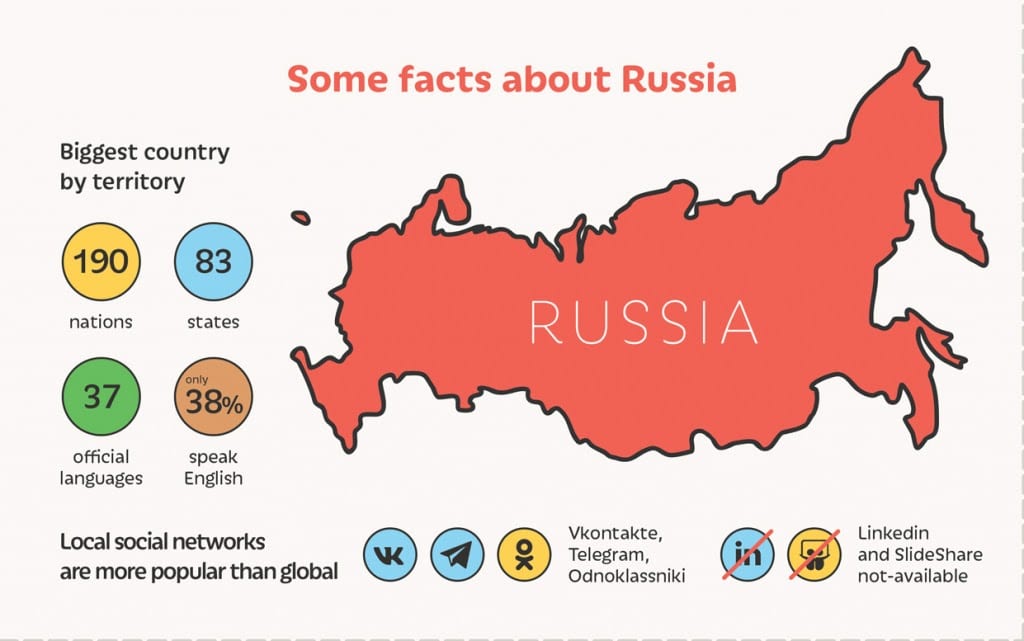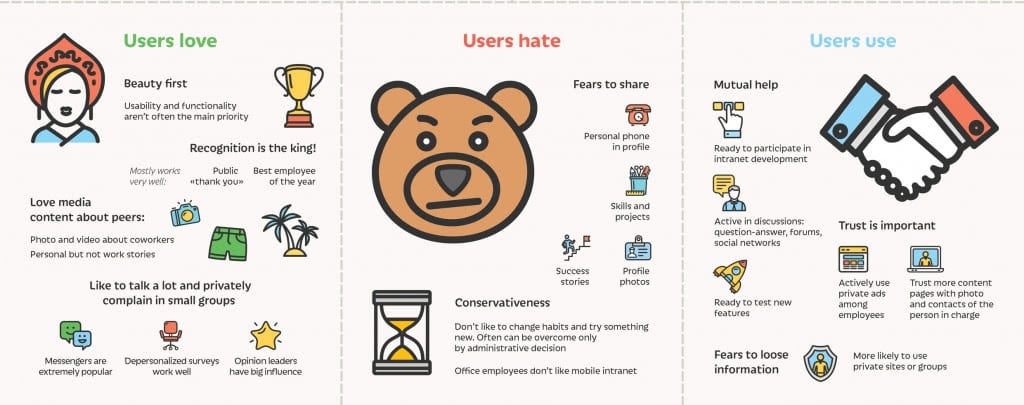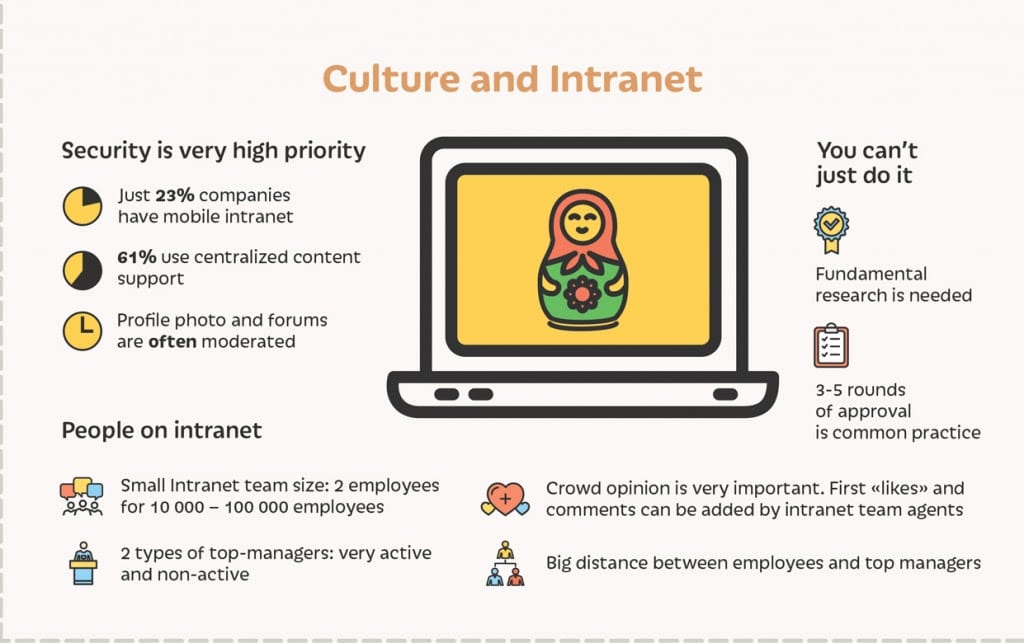What you never knew about Russian intranets
Culture impacts all elements of life, and intranets are no exception. As an intranet consultant, and having worked in this area for more than 10 years, I am passionate about intranets and digital workplaces. This blog goes some way to enlighten you on Russian culture and how it affects the way in which we design, build and use our intranets.
Little known facts about Russia
- Russia is the biggest country, by territory, and spans 11 time zones. For internal communications people that means any important announcement needs to be made before noon Moscow time, so that it can reach all the employees on that day.
- We have 36 government languages besides Russian, so often intranets need to support more than one language, in order to meet the local government rules of that region.
- Another factor that makes our intranets similar to global ones is the number of users. For example, the biggest Russian bank, Sberbank, which operates mostly in Russia, has more than 320,000 employees; the Russian railway employs 740,000; and the Russian postal service 390,000. “Smaller” commercial companies still employ huge numbers of people, for instance, metal and mining company “Evraz” – 80,000; retail company “X5 Retail group” – 250,000: “VTB bank” – 50,000. There are, of course, many small and medium-sized companies too.
- Another fact that surprises many people around the globe is that LinkedIn and Slideshare are not available in Russia. So, Facebook is the number one place for creating a business network and building professional communities. It’s not used as a place for sharing photos of family and friends, as it is in the rest of the world. Instead, people use Instagram and local social networks, such as Vkontakte and Telegram, for personal use. Vkontakte is also used by local companies as an enterprise social network (ESN), similar to Workplace by Facebook. For example, Yota uses Vkontakte. I will explain why Workplace by Facebook isn’t popular later.

Little known facts about Russian intranets
- While Office 365 is becoming more and more popular around the world, it isn’t in Russia. Companies don’t trust the cloud yet because of some political issues and also they love to customize, personalize, redesign and implement other complicated processes that can’t easily be done on Office 365. According to our survey of 76 companies in Russia, only 7% of respondents use Office 365.
- Only 30% of companies currently have a mobile version of the intranet. However, 40% of companies who don’t currently support mobile are planning to do so in the next 2 years.
- Our intranet teams are usually small. On average, there are just 2 FTEs despite the size of the companies (usually from 10,000 to 100,000 employees).
- On average, Russian companies spend 69,000 EUR on developing their intranets each year. Of course, there are some who spend more (up to 700,000 EUR) and many more who spend less (down to 15,000 EUR).
How users differ
Even if an international company has a global corporate culture, the behaviours of its intranet users can often differ due to local cultural characteristics. Here are some characteristics that stand out:
- Recognition is king. Competitions like “best photo”, special pages such as “best employee of the year”, gamification with public badges, and feeds with a public “thank you” to colleagues always work well.
- Users love media content about co-workers, but there aren’t many professional success stories.
- Conservative. Even though we used to live in a country of constant change, typically, users are reluctant to change their habits and behaviours.
- Afraid to share. Many prefer to stay under the radar and will not upload a photo or phone number to the intranet. In conservative companies, professional success stories can lead to jealousy amongst colleagues, so users prefer to stay quiet.
- Trusted content is important. A company’s internal “Сraigslist” can be extremely popular and help to involve users on the intranet. Pages on the intranet with a photo and contact details of the author are more popular and trusted.
- High-level managers can be very active on the intranet, generating lots of content, and promoting and involving users, but most remain inactive.

How culture affects intranets
- Unlike Nike, you can’t just do it. It’s not in our culture. In our culture, it’s all or nothing, no matter what. You can’t just have a snack at grandma’s house – you will be given a three-course meal instead. It’s the same with intranets. You can’t just create an intranet. Fundamental research and infinite rounds of approval are needed. Three to five rounds of approval for one document is common practice. In one of my projects, we had 44 versions of business requirements for the staff directory and 290 rounds of approval for the whole project.
- Security is a very high priority. Russians are obsessed with security and it comes with a large budget. As already mentioned, we don’t use the Cloud. Photos and forums are often moderated. All employee personal data should be stored inside the country; if not, there is a lot of paperwork to complete in order to store it abroad. This is why Workplace by Facebook isn’t very popular here.
- Analog and digital in one world. We exist in a world of contrasts: one part is very digital, the other is still analog. For external users, most services are very advanced – I have mobile apps to order taxis, food and coffee; I can rent an electric scooter or book an appointment without having to speak to anyone; I have a chatbot for my local grocery store; and I can pay for public transport using my phone. But in the corporate world, paper still thrives. For example, millions of employees across the country still print on paper or even submit a handwritten vacation request. Ordering guest passes or office supplies is also often done on paper or in semi-automatic mode.

Of course, things are changing. Ten years ago we used to stand in line for hours at polyclinics, public institutions and banks. Nowadays, we will wait just 5–10 minutes – but still get annoyed! Queueing was minimized by a digital government through what is known as GosUslugi, a public service portal where more than 1,000 government services are available to citizens, businesses and expats. For example, I use it to check my pension and to pay taxes, to book a doctor’s appointment, to request kindergarten for my daughter, to register a new car, and to pay to park anywhere in the city.
To draw the comparison, if you imagine citizens as employees of the government, I would say that GosUslugi is one of the largest digital workplaces in the world, with 64 million users. It has solved many business needs of the government – it optimizes processes and resources, develops customer loyalty and helps to generate money. In 2017, more than 30 billion rubles were paid to the government through the portal and more than 1.3 billion services provided.
Join my session on DW24 where I will showcase some of Russia’s best intranets and digital workplaces.

Free access for DWG members
Don’t forget! Digital Workplace Group members have free access to DW24 as part of their membership of DWG – just book via the DWG extranet.

TAKE THE NEXT STEP
Categorised in: Intranets


